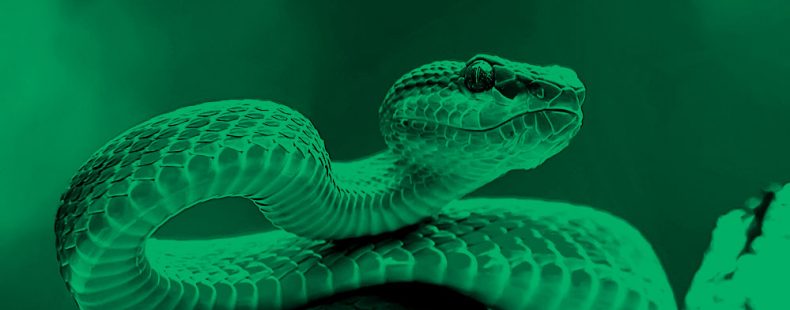Here’s the obvious thing about poison and venom: you don’t want either one in your body. But after that, things can get confusing. Although the two words are sometimes used interchangeably in casual use, a distinction is made between them in scientific contexts.
In this article, we’ll look at the key differences between poison and venom as well as the adjective forms poisonous and venomous, especially in the context of snakes, plants, and other living things.
⚡ Quick summary
The word poison can refer to any substance that is inherently harmful to a living thing—especially a substance that’s intended to be harmful. The word venom is more specific—it refers to a poisonous substance produced in the body of an animal and actively used to cause harm through injection, such as through a snake bite, a spider bite, or an insect sting. Venom is sometimes called poison in casual use, and animals that are venomous are sometimes casually described as poisonous, as in poisonous snakes. But in reference to organisms, there is a difference: poison is secreted through the skin or delivered through ingestion.
What is the difference between poison vs. venom?
The word poison can refer to any substance with an inherent property that makes it harmful or even deadly. The word is perhaps most often used to refer to substances that are intended to cause harm in this way, as in rat poison or The poison they used was a nerve agent.
The word poison is also sometimes used to refer to naturally occurring toxic chemicals and substances, such as arsenic or cyanide (which can also be used intentionally to cause harm). It’s also sometimes used to refer to manufactured chemicals that aren’t intended to cause harm but can if ingested, such as bleach or other cleaners.
The term venom is much more specific—it refers to a dangerous substance produced in the body of an animal, such as in some snakes, spiders, and wasps, and delivered via injection. Such animals may use venom as a way to defend themselves or as part of how they prey on other animals. Snakes are known for delivering venom via a bite, but some can spray or “spit” venom. Wasps and other insects can inject venom via stingers. Some jellyfish inject venom through barbed tentacles.
The toxicity of venom varies widely. The effects of different venoms range from minor irritation to death.
The toxic substances produced by some animals may be referred to as poison instead of venom. This is the case when the substance is simply secreted by the animal or stored inside its body (as in the poison-arrow frog), as opposed to being actively injected or sprayed.
Animals aren’t the only living things that produce poisonous substances. Many plants contain substances that are toxic if they’re ingested or come into contact with skin, but such a substance is typically called a poison as opposed to a venom.
Despite the technical distinction between the words, animal venom is sometimes generally referred to as poison.
Another difference in how we use the words: unlike the word venom, poison is also commonly used as a verb. It can mean “to administer poison to (a person or animal)” or “to add poison to something,” as in She poisoned the soup.
poisonous vs. venomous
The adjective poisonous is used broadly to describe substances that are considered poisons. It may also be applied to things that contain a substance considered a poison, as in The leaves of that plant are poisonous.
The adjective venomous is more narrowly applied to animals that produce venom, especially if they’re able to inject that venom as a way of actively defending themselves or preying on other animals.
However, in the context of animals, the word poisonous is often used casually to mean the same thing as venomous, such as in terms like poisonous snakes, which is often used to distinguish such snakes from ones that don’t have venom.
Although rare, it’s possible for an animal to be accurately described as both poisonous and venomous. The Asian tiger snake is one commonly cited example of this: it has a venomous bite, but it’s also poisonous because its body contains the poison from the poisonous toads that it eats.














